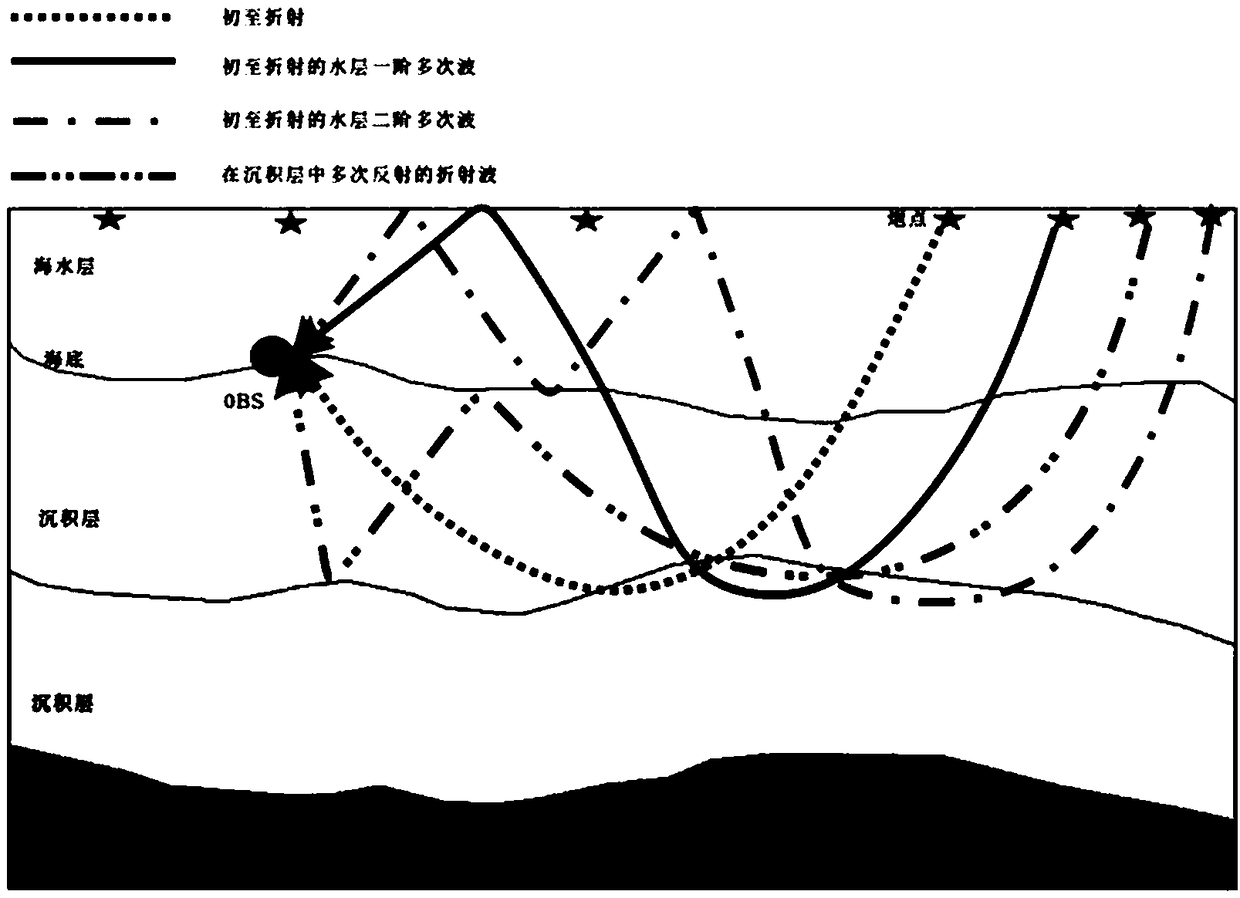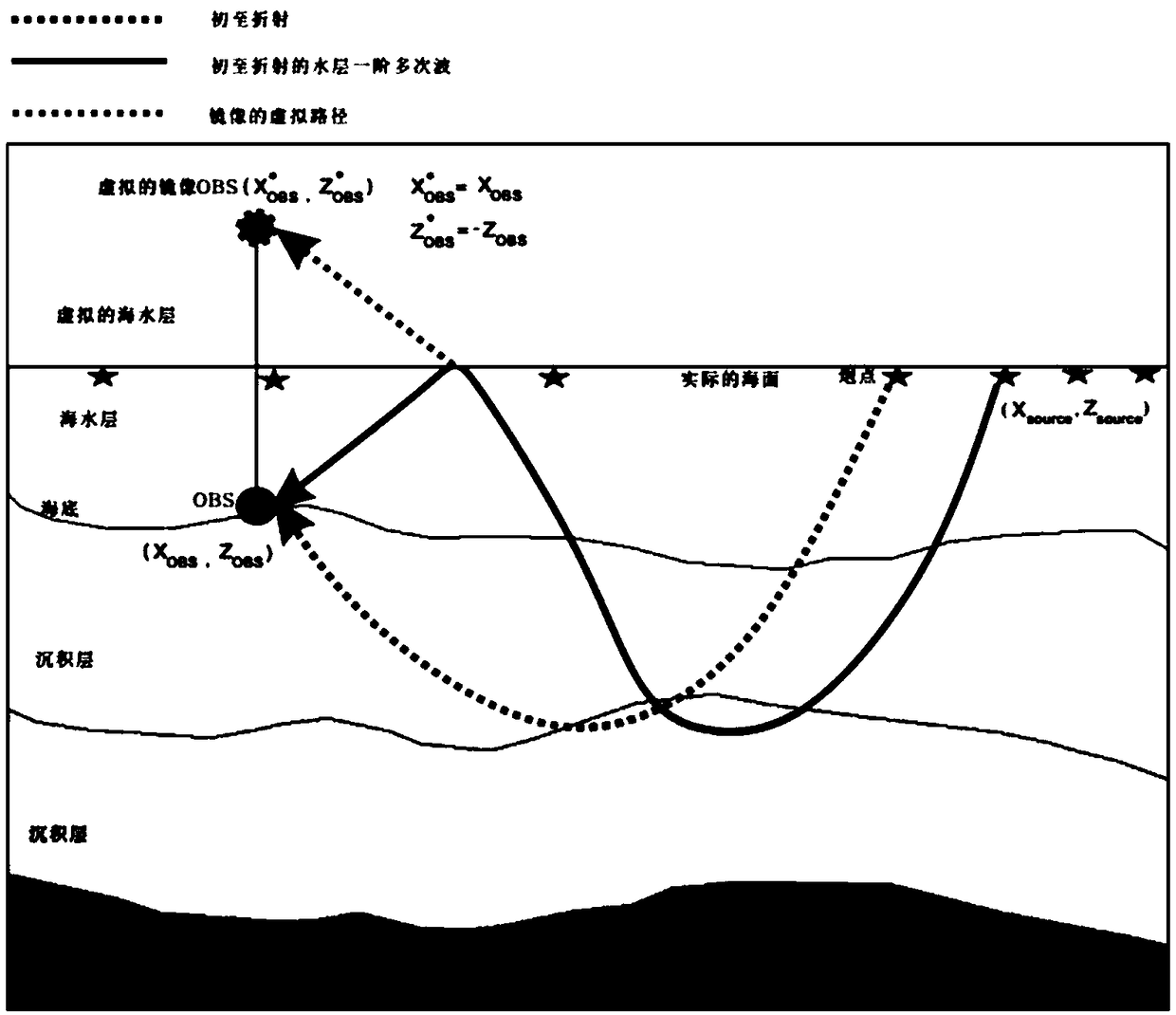Method and device for realizing refraction multi-wave tomography inversion, and processing terminal
A tomographic inversion and multiple wave technology, applied in seismic signal processing and other directions, can solve the problems of difficulty in picking up reflected waves, a large number of calculations, and low reliability of picking results.
- Summary
- Abstract
- Description
- Claims
- Application Information
AI Technical Summary
Problems solved by technology
Method used
Image
Examples
Embodiment 1
[0092] Such as figure 1 As shown, the present invention discloses a method for realizing refraction multiple wave tomographic inversion, which is characterized in that it comprises the following steps:
[0093] S1. When picking up the travel time of the refracted wave at the first arrival, denote it as t obs , when picking up the travel of the first-order multiples at the first arrival in the refracted water layer, it is denoted as
[0094] S2. Add a virtual seawater layer above the sea surface, and use the mirror image principle to Converted to the travel time of the first-arrival refracted wave on the mirrored OBS point in the virtual seawater layer, it is recorded as
[0095] S3, merge all t obs and denoted as T obs , the T obs Constituting the input data for the inversion of first-arrival refraction traveltime;
[0096] S4. Define the target functional of the first-arrival refraction travel time inversion as where m is the velocity model, T cal (m) The actu...
Embodiment 2
[0123] Such as Figure 9 As shown, the present invention discloses a device for realizing refraction multiple wave tomographic inversion, including the following modules:
[0124] The pick-up module is used to pick up the travel time of the first-arrival refracted wave, denoted as t obs , when picking up the travel of the first-order multiples at the first arrival in the refracted water layer, it is denoted as
[0125] The conversion module is used to add a virtual seawater layer above the sea surface, and the described Converted to the travel time of the first-arrival refracted wave on the mirrored OBS point in the virtual seawater layer, it is recorded as
[0126] Merge module for merging all t obs and denoted as T obs , the T obs Constituting the input data for the inversion of first-arrival refraction traveltime;
[0127] definition module for defining the target functional for first-arrival refraction traveltime inversion as where m is the velocity model, T...
Embodiment 3
[0142] Such as Figure 10 As shown, the present invention discloses a processing terminal, including:
[0143] memory for storing program instructions;
[0144] a processor for executing the program instructions to perform the following steps:
[0145] S1. When picking up the travel time of the refracted wave at the first arrival, denote it as t obs , when picking up the travel of the first-order multiples at the first arrival in the refracted water layer, it is denoted as
[0146] S2. Add a virtual seawater layer above the sea surface, and use the mirror image principle to Converted to the travel time of the first-arrival refracted wave on the mirrored OBS point in the virtual seawater layer, it is recorded as
[0147] S3, merge all t obs and denoted as T obs , the T obs Constituting the input data for the inversion of first-arrival refraction traveltime;
[0148] S4. Define the target functional of the first-arrival refraction travel time inversion as where ...
PUM
 Login to View More
Login to View More Abstract
Description
Claims
Application Information
 Login to View More
Login to View More - R&D
- Intellectual Property
- Life Sciences
- Materials
- Tech Scout
- Unparalleled Data Quality
- Higher Quality Content
- 60% Fewer Hallucinations
Browse by: Latest US Patents, China's latest patents, Technical Efficacy Thesaurus, Application Domain, Technology Topic, Popular Technical Reports.
© 2025 PatSnap. All rights reserved.Legal|Privacy policy|Modern Slavery Act Transparency Statement|Sitemap|About US| Contact US: help@patsnap.com



